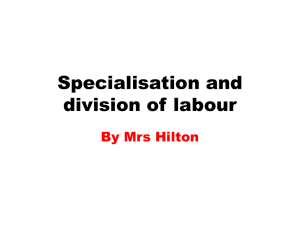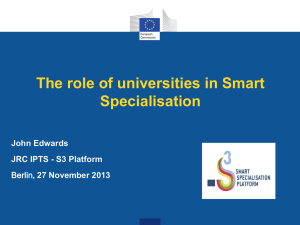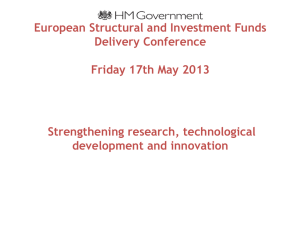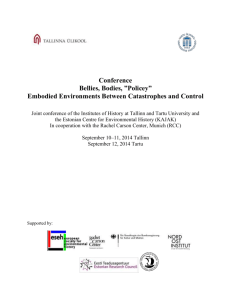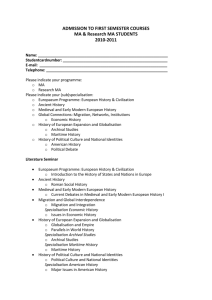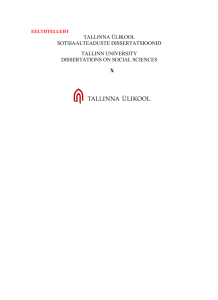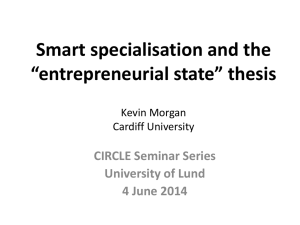Smart specialisation strategy for the South
advertisement
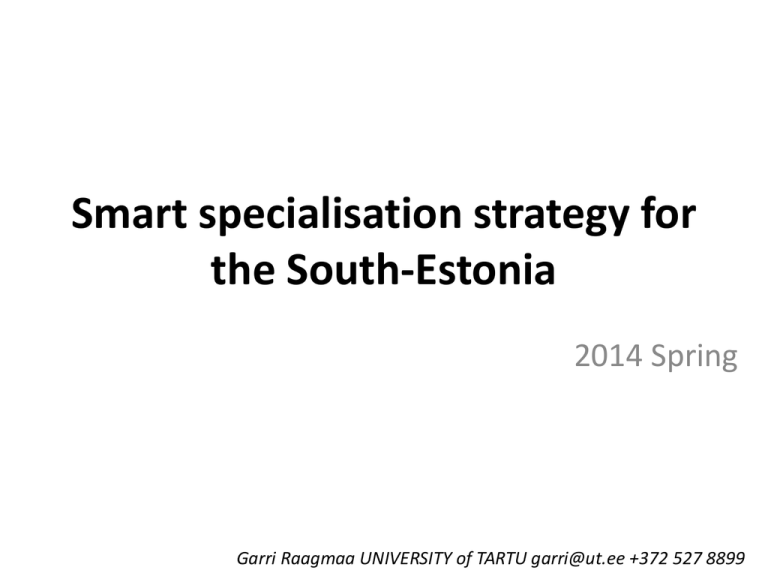
Smart specialisation strategy for the South-Estonia 2014 Spring Garri Raagmaa UNIVERSITY of TARTU garri@ut.ee +372 527 8899 South-Estonia in a Nutshell • 325 th. inhabitants & 15 th square km territory • Traditionally dominated by agriculture and forestry • Peripheral location: 2-4 hours driving distance from the main transport hubs - capital Tallinn or Latvian capital Riga (only one flight to Helsinki from Tartu) • South-Estonian centre Tartu is old university and medical centre – characterised by low level entrepreneurship – dominance of publicly financed institutions Overall context • Estonia depends 2013-20 heavily on EU investment grants • EU requirements for the strategies of smart specialisation • Estonian central ministries act like silos – everyone has it’s own smart specialisation • Local authorities are dispersed and have low administrative and development capacity • Predominant is centralist and elitist approach: – Understanding smart specialisation as something high tech and science related – smart specialisation so far managed from Tallinn only Warning of too narrow approch in SS by D.Foray Sectoral level Sleeping giant agrofood Excited goblings high tech cluster Hungry dwarfs low tech SMEs A narrow view of smart specialisation! Source: Foray 2012 Central agencies of SS • Ministries of Education and Economy – Development Fund and Estonian Enterprise as implementing agencies • Ministry of Interior – regional SS • Ministry of Agriculture – Primary sector R&D – LEADER programmes • Ministry of Culture – creative industries • Ministry of Social Affairs – – Major investments to hospitals – training programs South-Estonian (SE) approach to SS • Everybody, except Tallinn civil cervants, hate papers! • Awareness rising and involvement of SE institutions – Larger local governments – County governments – Regional business development centres (BAS) • Defining growing business sectors and their needs for R&D • Involving central ministries and agencies to the process – Promoting place based entrepreneurial discovery model – Combining central measures suitable for the SE • SESSS - NOT A PAPER BUT NETWORKING PROCESS ACTIVATING DIFFERENT SS-STAKEHOLDERS Action so far • SE economic sectors overview done by Fac. of Econ. • Involvement of larger urban centres of SE – Personal contacts & two meetings • Discussing possible collaboration with SE county development departments and BAS • Networking with most promising enterprise clusters / domains -> what are their R&D needs? • Communication with ministries and central agencies – involving key persons responsible for SS application to the SESSS process Further action with SESSS • Combining central agencies SS-related measures to meet bottom up initiatives – Defining/selling SS Domains for the SE public – Designing and choosing viable projects for a SS shopping list“ acceptable for central agencies • Building up South-Estonian institutional capacity based on Tartu Science park & South-Estonian BAS-network – Securing entrepreneurial discovery taking place in SE • Involvement and linking SE enterprise (their unions) with the SS shopping list as beneficiaries (owners) – Agreeing on projects and enterprise side co-finance • Public awareness rising via media Results by the end of May (ideal) • Representatives of South-Estonian key public institutions and enterprise leaders have true knowledge about the options provided by the national SS-measures • Agreement on the SESS domains achieved: – Shortlist of SS/enterprise development related projects to be developed agreed among stakeholders • Input to the county (6) development plans • Agreement with the Estonian Enterprise and Development fund on the application of some SSmeasure by SE-based institutions Comments about the SE domains • Wooden houses: great growth rates but low R&D • Food & milk sector: dominance of large multinational firms not interested about local R&D • Health/biotech sector: strong research capacity, very different companies (by size and business models) – Red biotech still science related and not business minded – Green biotech has Dairy Competence Centre and several patents developed during the last programming period • ICT & electronics/mechatronics – Software development - a quite number of globally competitive firms – Regional industrial software and elecronics still embryonic
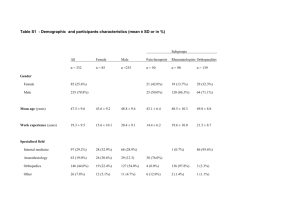
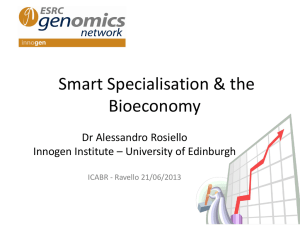
![[I-2] Mahr](http://s2.studylib.net/store/data/005533114_2-575c16bb39129d77e4fc404ccab7077e-300x300.png)
